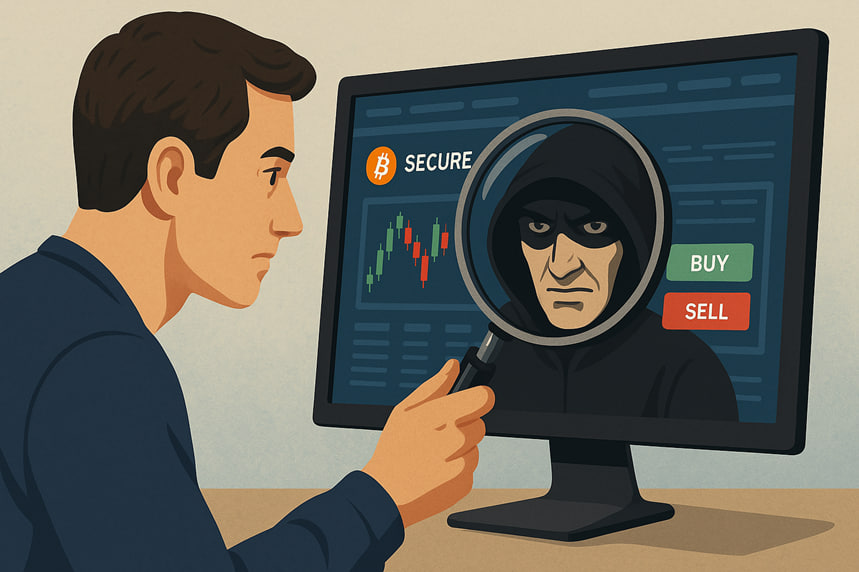How to Stay Safe from Crypto Scams in 2025

Contents
- Introduction
- What Is a Crypto Scam
- Types of Crypto Scams
- How to Recognize a Crypto Scam
- How to Protect Yourself from Crypto Scams
- What to Do If You Become a Victim of a Crypto Scam
- Conclusion
Introduction
A Brief Overview of Cryptocurrencies and Crypto Scams
Cryptocurrency is a form of digital money that exists solely on the internet. It has no physical counterpart. People use these coins for purchases, exchanges, and investments. The most well-known examples are Bitcoin and Ethereum, but many other tokens exist.
The popularity of cryptocurrencies grows each year, and more and more people are eager to profit from this market. However, with increasing interest comes rising fraud. Scammers are constantly inventing new ways to deceive users and steal their money. This article will explore how these scams work and how to avoid falling for them.
Reasons Behind the Growing Popularity of Cryptocurrencies and the Rise of Related Scams
Cryptocurrency appeals to users because of its freedom. You can own it without banks, verifications, or restrictions. Transactions are fast, and accounts can be opened within minutes. This makes crypto especially attractive for those seeking anonymity.
But this freedom makes cryptocurrency a convenient tool for scammers. Regulatory systems in this space are still underdeveloped. Many countries have yet to introduce laws that protect investors, which allows criminals to act without fear of punishment. People lose money, and tracking down the culprits is nearly impossible.
What Is a Crypto Scam

Definition of a Crypto Scam
A crypto scam is a form of fraud involving cryptocurrencies. Victims lose money due to false information, fake projects, or fraudulent platforms. These scams often appear legitimate: sleek websites, convincing content, and so-called “experts.” But behind the façade lies deception.
The main goal of scammers is to convince victims to send them cryptocurrency. Once the funds are sent, communication ends, and the money is gone for good. That’s why it’s so important to understand how these schemes work in advance.
Types of Crypto Scams
Scammers use dozens of methods to steal other people’s money. Below are the most common types of scams observed in 2025. Each is designed to look honest and trustworthy, ultimately leading to financial loss.
Investment Schemes
Scammers create websites or channels promising high returns on crypto investments. They often claim to have a “secret strategy” or “insider knowledge.” They promise huge profits quickly and stress that this is a “once-in-a-lifetime deal” or a “final opportunity.”
Sometimes, they pose as experienced traders. To build trust, they publish fake reports, charts, and even “customer reviews.” In reality, the funds are simply transferred to the scammer’s wallet.
Example: The “BitPetite” scheme promised income from renting mining servers. The project ran for several months, accepted deposits, and even paid early users. But once the flow of new money dried up, the site disappeared, and the creators vanished with the funds.
Fake Exchanges
Some scammers create clones of legitimate exchanges. The websites look almost identical, with logos, charts, and real-time prices. However, once a user deposits money, they cannot withdraw it. Customer support is unresponsive, and the site eventually vanishes.
Other versions involve simulated trading. Users see apparent profits, but when they try to withdraw, they’re asked to pay a “tax” or “fee.” After paying, withdrawals remain unavailable.
Example: The fake exchange “BitKRX” used the name of South Korea’s KRX stock exchange. The site looked trustworthy, but no real trading occurred. Users deposited money and never saw it again.
Fake ICOs (Initial Coin Offerings)
Scammers invent fake projects and launch so-called ICOs to collect funds for new tokens. Their websites feature lofty goals, whitepapers, and detailed roadmaps, and they promise that the token’s value will multiply.
Victims buy these tokens early, hoping for gains. But the developers disappear with the money. The token might even exist on the blockchain, but it’s worthless.
Example: In 2017, “Plexcoin” raised about $15 million, promising a 1354% return in one month. The U.S. Securities and Exchange Commission (SEC) later froze the creators’ accounts, but most investors never recovered their money.
Fake Tokens
This type of scam is evolving rapidly. Today, scammers don’t just create worthless coins—they use sophisticated tricks that are hard to detect. Here are a few typical schemes:
-
Honeypot These tokens are actively traded. Users can buy them and even see price increases. But when they attempt to sell, they can’t. The smart contract prevents the transaction, and the funds are trapped.
Example: The token “SaveTheKids” appeared to be a charity project promoted by influencers. After launch, it became clear that tokens couldn’t be sold—the contract rules blocked all withdrawal attempts.
-
Rug Pulls Developers create a token and add limited liquidity (e.g., paired with ETH or USDT). They then promote it on social media. As prices rise and more buyers join, the developers suddenly remove all liquidity. The token becomes unsellable, and its value crashes to zero.
Example: “Squid Game Token” raised hundreds of thousands of dollars during the show’s peak popularity. Its price soared, but within days, the developers pulled all liquidity. The token crashed to zero, and investors were left empty-handed.
-
Cloned Popular Tokens Scammers sometimes create tokens that closely resemble well-known coins. The difference may be a single character in the name or contract address. Users who don’t verify the details end up buying counterfeits.
Example: Fake versions of tokens like SHIBA or PEPE frequently appear on the BNB network. People see a familiar name and buy without checking the contract address. These fake tokens have no connection to the original and are used solely to defraud buyers.
How to Recognize a Crypto Scam

Scam schemes often look polished and convincing. Knowing what to look for is essential to avoid falling into a trap. Below are warning signs that can help you spot fraud early.
Common Traits of Fraudulent Offers
Scammers create urgency. They pressure users emotionally and promise easy profits. Their goal is to force a quick decision. These offers often lack precise details and rely on catchy phrases and unrealistic promises. Legitimate projects are transparent—they provide documentation, list their team, and explain terms clearly.
Unrealistic Promises: Guaranteed Profits and No Risk
If someone promises a guaranteed 100% return in a week, it’s a scam. No one can guarantee profits in crypto. Even major coins can drop in value suddenly. Any claim of “no risk” is a red flag.
Vague Terms and Lack of Transparency
Scammers rarely explain how their operations work. They avoid specific wording. Websites may contain a lot of text but little substance. Often, there’s no contact info, no legal address, and no explanation of fund allocation. If you don’t know where your money is going, it’s better not to go on.
No Licenses or Regulatory Certifications
Trusted crypto platforms operate with licenses. They undergo audits and follow legal regulations. If a platform doesn’t show any legal documents, be cautious. Scammers often refer to “international registration,” but never provide absolute proof.
How to Protect Yourself from Crypto Scams

Following a few simple rules can help you protect yourself in advance. These steps can help safeguard your funds and keep you out of danger.
How to Choose Safe and Reliable Crypto Platforms
Before registering on a platform, research its history and verify its web address through official sources (such as the project’s verified social media). A promising sign is a long-standing reputation and a large user base. Stick to well-known exchanges frequently mentioned in reputable sources. These companies provide clear terms, active support, and real contact information.
Use Two-Factor Authentication and Strong Passwords
Even if you choose a reliable platform, protect your account. Enable two-factor authentication—it’s a simple and effective security layer. Also, avoid weak passwords. Use a unique combination of letters, numbers, and symbols. Never share your password or store it in unsecured locations.
Verify Licenses and Company Reputation
Before investing, check whether the company holds a license. This information should be available on their official website. Also, read user reviews on forums and social media. Stay away if you see complaints about frozen accounts, delayed payouts, or unresponsive support.
Beware of “Too Good to Be True” Offers
If someone offers returns 10 times higher than the market average, that’s a red flag. Legitimate projects don’t make miraculous claims. Scammers use hype to lure victims. Don’t trust anyone who says, “This is your last chance” or “Only available today”.
Be Careful When Sending or Exchanging Crypto
Always double-check wallet addresses. One wrong character can send your money to the wrong place. When using an exchange service, research its reputation first. Check how long it has operated, whether there are complaints, and how customer support works.
What to Do If You Become a Victim of a Crypto Scam

If you’ve lost money to fraud, don’t stay silent. You can take steps to reduce losses and potentially recover your funds.
Where to Seek Help
First, file a report with your local police. If the scam happened via social media, report it on that platform. Some exchanges and blockchain projects also assist in such cases, especially if reported promptly.
How to Collect Evidence
Save all correspondence, receipts, wallet addresses, website links, and other relevant materials. Take screenshots, download emails, and note down profile names. This information may help police or legal professionals. The more evidence you gather, the better the chance of holding the scammers accountable.
Possibility of Fund Recovery or Legal Action
Recovering lost cryptocurrency is difficult, but not always impossible. If the scammer used an exchange with a functioning security department, it may be possible to freeze the stolen funds. Legal assistance can sometimes be practical, especially if the perpetrator is in your country. The key is to act quickly and not give up.
Conclusion
Cryptocurrency offers many opportunities, but it also comes with risks. Scammers are becoming more sophisticated and cunning. To avoid falling victim, you must stay alert. Never trust promises of easy money, always verify information, and don’t rush into decisions. In the world of crypto, security should always come first.